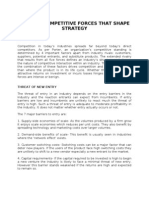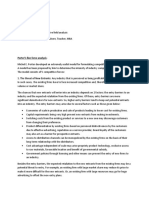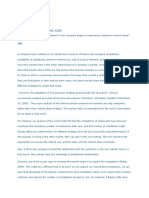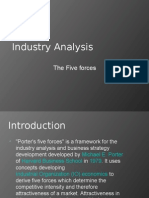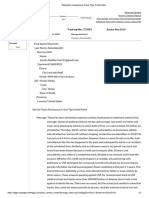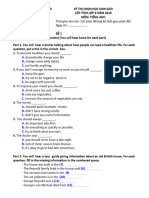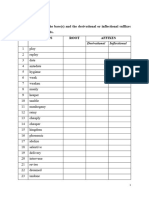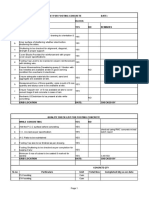Porters Five Force Model
Porters Five Force Model
Uploaded by
naveen sunguluruCopyright:
Available Formats
Porters Five Force Model
Porters Five Force Model
Uploaded by
naveen sunguluruOriginal Description:
Copyright
Available Formats
Share this document
Did you find this document useful?
Is this content inappropriate?
Copyright:
Available Formats
Porters Five Force Model
Porters Five Force Model
Uploaded by
naveen sunguluruCopyright:
Available Formats
Threat of New Entrants.
The average entrepreneur can’t come along and start a large
insurance company. The threat of new entrants lies within the insurance industry
itself. Some companies have carved out niche areas in which they underwrite
insurance. These insurance companies are fearful of being squeezed out by the big
players. Another threat for many insurance companies is other financial services
companies entering the market.
Power of Suppliers. The suppliers of capital might not pose a big threat, but the
threat of suppliers luring away human capital does. If a talented insurance
underwriter is working for a smaller insurance company (or one in a niche industry),
there is the chance that person will be enticed away by larger companies looking to
move into a particular market.
Power of Buyers. The individual doesn’t pose much of a threat to the insurance
industry. Large corporate clients have a lot more bargaining power with insurance
companies. Large corporate clients like airlines and pharmaceutical companies pay
millions of dollars a year in premiums. Insurance companies try extremely hard to get
high-margin corporate clients.
Availability of Substitutes. This one is pretty straight forward, for there are plenty of
substitutes in the insurance industry. Most large insurance companies offer similar
suites of services. Whether it is auto, home, commercial, health or life insurance,
chances are there are competitors that can offer similar services. In some areas of
insurance, however, the availability of substitutes is few and far between. Companies
focusing on niche areas usually have a competitive advantage, but this advantage
depends entirely on the size of the niche and on whether there are any barriers
preventing other firms from entering.
Competitive Rivalry. The insurance industry is becoming highly competitive. The
difference between one insurance company and another is usually not that great. As
a result, insurance has become more like a commodity – an area in which the
insurance company with the low cost structure, greater efficiency and better
customer service will beat out competitors. Insurance companies also use higher
investment returns and a variety of insurance investment products to try to lure in
customers. In the long run, we’re likely to see more consolidation in the insurance
industry. Larger companies prefer to take over or merge with other companies rather
than spend the money to market and advertise to people
Porter Five Forces is a holistic strategy framework that took strategic decision away from just
analyzing the present competition. Porter Five Forces focuses on - how MetLife, Inc. can
build a sustainable competitive advantage in Life Insurance industry. Managers at MetLife,
Inc. can not only use Porter Five Forces to develop a strategic position with in Life Insurance
industry but also can explore profitable opportunities in whole Financial sector.
MetLife, Inc. Porter Five (5) Forces Analysis for
Financial Industry
Threats of New Entrants
New entrants in Life Insurance brings innovation, new ways of doing things and put pressure
on MetLife, Inc. through lower pricing strategy, reducing costs, and providing new value
propositions to the customers. MetLife, Inc. has to manage all these challenges and build
effective barriers to safeguard its competitive edge.
How MetLife, Inc. can tackle the Threats of New Entrants
By innovating new products and services. New products not only brings new customers to
the fold but also give old customer a reason to buy MetLife, Inc. ‘s products.
By building economies of scale so that it can lower the fixed cost per unit.
Building capacities and spending money on research and development. New entrants are
less likely to enter a dynamic industry where the established players such as MetLife, Inc.
keep defining the standards regularly. It significantly reduces the window of extraordinary
profits for the new firms thus discourage new players in the industry.
Bargaining Power of Suppliers
All most all the companies in the Life Insurance industry buy their raw material from
numerous suppliers. Suppliers in dominant position can decrease the margins MetLife, Inc.
can earn in the market. Powerful suppliers in Financial sector use their negotiating power to
extract higher prices from the firms in Life Insurance field. The overall impact of higher
supplier bargaining power is that it lowers the overall profitability of Life Insurance.
How MetLife, Inc. can tackle Bargaining Power of the Suppliers
By building efficient supply chain with multiple suppliers.
By experimenting with product designs using different materials so that if the prices go up of
one raw material then company can shift to another.
Developing dedicated suppliers whose business depends upon the firm. One of the lessons
MetLife, Inc. can learn from Wal-Mart and Nike is how these companies developed third
party manufacturers whose business solely depends on them thus creating a scenario where
these third party manufacturers have significantly less bargaining power compare to Wal-
Mart and Nike.
Bargaining Power of Buyers
Buyers are often a demanding lot. They want to buy the best offerings available by paying
the minimum price as possible. This put pressure on MetLife, Inc. profitability in the long run.
The smaller and more powerful the customer base is of MetLife, Inc. the higher the
bargaining power of the customers and higher their ability to seek increasing discounts and
offers.
How MetLife, Inc. can tackle the Bargaining Power of Buyers
By building a large base of customers. This will be helpful in two ways. It will reduce the
bargaining power of the buyers plus it will provide an opportunity to the firm to streamline its
sales and production process.
By rapidly innovating new products. Customers often seek discounts and offerings on
established products so if MetLife, Inc. keep on coming up with new products then it can limit
the bargaining power of buyers.
New products will also reduce the defection of existing customers of MetLife, Inc. to its
competitors.
Threats of Substitute Products or Services
When a new product or service meets a similar customer needs in different ways, industry
profitability suffers. For example services like Dropbox and Google Drive are substitute to
storage hardware drives. The threat of a substitute product or service is high if it offers a
value proposition that is uniquely different from present offerings of the industry.
How MetLife, Inc. can tackle the Treat of Substitute Products /
Services
By being service oriented rather than just product oriented.
By understanding the core need of the customer rather than what the customer is buying.
By increasing the switching cost for the customers.
Rivalry among the Existing Competitors
If the rivalry among the existing players in an industry is intense then it will drive down prices
and decrease the overall profitability of the industry. MetLife, Inc. operates in a very
competitive Life Insurance industry. This competition does take toll on the overall long term
profitability of the organization.
How MetLife, Inc. can tackle Intense Rivalry among the Existing
Competitors in Life Insurance industry
By building a sustainable differentiation
By building scale so that it can compete better
Collaborating with competitors to increase the market size rather than just competing for
small market.
Implications of Porter Five Forces on MetLife,
Inc.
By analyzing all the five competitive forces MetLife, Inc. strategists can gain a complete
picture of what impacts the profitability of the organization in Life Insurance industry. They
can identify game changing trends early on and can swiftly respond to exploit the emerging
opportunity. By understanding the Porter Five Forces in great detail MetLife, Inc. 's
managers can shape those forces in their favor.
You might also like
- Epstein Documents (Jan. 3)Document943 pagesEpstein Documents (Jan. 3)CTV News81% (42)
- The Five Competitive Forces That Shape StrategyDocument5 pagesThe Five Competitive Forces That Shape StrategyAmol Deherkar75% (4)
- The Competitive EnvironmentDocument8 pagesThe Competitive EnvironmentElaine MorenoNo ratings yet
- Porter's Five Forces: Understand competitive forces and stay ahead of the competitionFrom EverandPorter's Five Forces: Understand competitive forces and stay ahead of the competitionRating: 4 out of 5 stars4/5 (10)
- Strategic Alliances: Three Ways to Make Them WorkFrom EverandStrategic Alliances: Three Ways to Make Them WorkRating: 3.5 out of 5 stars3.5/5 (1)
- Porter's Five ForcesDocument3 pagesPorter's Five ForcesAdrian FloresNo ratings yet
- EABD AssignmentDocument7 pagesEABD Assignmentgag gaganNo ratings yet
- Porter XXXDocument7 pagesPorter XXXAmol DeherkarNo ratings yet
- The Five Forces ModelDocument4 pagesThe Five Forces ModelVu PhamNo ratings yet
- Entrepreneurship Assignment: 2: Name: Registration NoDocument5 pagesEntrepreneurship Assignment: 2: Name: Registration NoUMAIR TARIQ L1F17BBAM0054No ratings yet
- Conglomerates 5 Porter AnalysisDocument3 pagesConglomerates 5 Porter AnalysisKhushe BothraNo ratings yet
- Five Competitive Forces That Shape StrategyDocument5 pagesFive Competitive Forces That Shape StrategyKAVIN KNo ratings yet
- MKTNG Unit 5Document42 pagesMKTNG Unit 5Anusha UnnikrishnanNo ratings yet
- Reviewer Compre 1Document30 pagesReviewer Compre 1Dexter AlcantaraNo ratings yet
- Industry AnalysisDocument13 pagesIndustry AnalysisKasiira HatimuNo ratings yet
- Question 1: Consider You Are Opening A New Business, So To Know The Market Trends of TheDocument4 pagesQuestion 1: Consider You Are Opening A New Business, So To Know The Market Trends of TheZia Ullah KhanNo ratings yet
- Notes For Assignment 2Document15 pagesNotes For Assignment 2phyu trezaNo ratings yet
- Chapter 4: Environmental Scanning and Industry AnalysisDocument5 pagesChapter 4: Environmental Scanning and Industry AnalysismadihaNo ratings yet
- Industry Analysis FinalDocument18 pagesIndustry Analysis FinalManaf BasheerNo ratings yet
- Zisengwe - Michael Porter-86Document8 pagesZisengwe - Michael Porter-86api-277217137No ratings yet
- Michael Porter The Proponent of These 5 ForcesDocument2 pagesMichael Porter The Proponent of These 5 ForcesJohn Kenneth EksdieNo ratings yet
- Experience CurveDocument8 pagesExperience CurveKeshab KothariNo ratings yet
- Porter's Five Five Force Analysis (Part-1)Document4 pagesPorter's Five Five Force Analysis (Part-1)Pooja Rani-48No ratings yet
- Porters 5 ForcesDocument12 pagesPorters 5 ForcesUtakarsh JayantNo ratings yet
- 5 ForceDocument5 pages5 ForceMichael YongNo ratings yet
- Industry Analysis Is A Tool That Facilitates A CompanyDocument3 pagesIndustry Analysis Is A Tool That Facilitates A CompanyAri NugrahaNo ratings yet
- Porter's Five Factor AnalysisDocument11 pagesPorter's Five Factor AnalysisPrajaktha PrakashNo ratings yet
- Mib Unit 2 NotesDocument29 pagesMib Unit 2 NotesPriya ChauhanNo ratings yet
- Industry Life CycleDocument25 pagesIndustry Life CycleLucia NiculaeNo ratings yet
- Econ Homework # 2Document3 pagesEcon Homework # 2Alfonso Jr. BusaNo ratings yet
- Strategy AssignmentDocument4 pagesStrategy AssignmentRavulapati NagarajuNo ratings yet
- Porter's Five Forces: Understanding Competitive Forces To Maximize ProfitabilityDocument16 pagesPorter's Five Forces: Understanding Competitive Forces To Maximize ProfitabilityAnup SharmaNo ratings yet
- Chapter 10 ReportDocument29 pagesChapter 10 ReportMay Jude Dela CruzNo ratings yet
- PESTLE AnalysisDocument13 pagesPESTLE AnalysisAlzen Marie DelvoNo ratings yet
- Industry Analysis: Positioning The FirmDocument5 pagesIndustry Analysis: Positioning The FirmDonrost Ducusin Dulatre100% (1)
- Porter Five Forces AnalysDocument8 pagesPorter Five Forces Analysasimmba19No ratings yet
- BS Final Assignment 2023Document5 pagesBS Final Assignment 2023Thảo NguyễnNo ratings yet
- Porter ColgateDocument5 pagesPorter ColgateMuhammad ShakeelNo ratings yet
- The Boston Consulting GroupDocument9 pagesThe Boston Consulting GroupVipul AggarwalNo ratings yet
- Porter's Five Factor Model: Rivalry Among The Existing CompetitorsDocument3 pagesPorter's Five Factor Model: Rivalry Among The Existing CompetitorsMahmoda ZannatNo ratings yet
- Porters 5 Forces AnalysisDocument11 pagesPorters 5 Forces AnalysisSarah AlsuiltyNo ratings yet
- SM AssignmentDocument10 pagesSM AssignmentvaibhavNo ratings yet
- Amit Gogle ClassroomDocument5 pagesAmit Gogle ClassroomMix VidNo ratings yet
- SM Class Notes 10022018Document30 pagesSM Class Notes 10022018Pulkit GoelNo ratings yet
- The Strategic Planning ProcessDocument39 pagesThe Strategic Planning Processakash0chattoorNo ratings yet
- Industry AnalysisDocument7 pagesIndustry AnalysisNethiyaaRajendranNo ratings yet
- Industry Handbook: Porte: R's 5 Forces AnalysisDocument20 pagesIndustry Handbook: Porte: R's 5 Forces AnalysisAnitha GirigoudruNo ratings yet
- Wk2 DQ1: Discussion Question 1 - CLO1, CLO2Document18 pagesWk2 DQ1: Discussion Question 1 - CLO1, CLO2Samixa TimalcenaNo ratings yet
- Project Wipro LimitedDocument5 pagesProject Wipro LimitedMehul DevatwalNo ratings yet
- NOTES - PART 3 - BIT 3105 Management Information SystemsDocument63 pagesNOTES - PART 3 - BIT 3105 Management Information Systemsnyakangomicah4No ratings yet
- Competitive Strategy: (Summary)Document11 pagesCompetitive Strategy: (Summary)Jason Patrick PastranaNo ratings yet
- Competitive Strategy. Porter Father of Modern StrategyDocument6 pagesCompetitive Strategy. Porter Father of Modern StrategyMostafa hosnyNo ratings yet
- Assignment# 1 Porter's Five-Force Model: Sheraz Hassan Mba 1.5 2nd Roll No F-016 - 019 Subject Strategic ManagementDocument4 pagesAssignment# 1 Porter's Five-Force Model: Sheraz Hassan Mba 1.5 2nd Roll No F-016 - 019 Subject Strategic ManagementFaisal AwanNo ratings yet
- Chap 2 Michael Pettus Strategic Decision MakingDocument6 pagesChap 2 Michael Pettus Strategic Decision MakingSo PaNo ratings yet
- Wassim Zhani KrogerDocument13 pagesWassim Zhani Krogerwassim zhaniNo ratings yet
- SM-unit 3Document23 pagesSM-unit 3mmuthulaxmi13No ratings yet
- 7bTHE STRATEGIC PLANNING PROCESS, PART 1 & 2Document22 pages7bTHE STRATEGIC PLANNING PROCESS, PART 1 & 2Sakura CnNo ratings yet
- IndustIndustry Analysis - 5 ForcesDocument36 pagesIndustIndustry Analysis - 5 ForcesSIVAKUMAR_GNo ratings yet
- International BusinessDocument7 pagesInternational BusinessSolve AssignmentNo ratings yet
- SWOT Analysis of SamsunGDocument47 pagesSWOT Analysis of SamsunGRohit PathakNo ratings yet
- Competitive FactorDocument14 pagesCompetitive FactorAhmad Hafid HanifahNo ratings yet
- CACEnglish PDFDocument106 pagesCACEnglish PDFnaveen sunguluruNo ratings yet
- SLP - Role DescriptionDocument2 pagesSLP - Role Descriptionnaveen sunguluruNo ratings yet
- CRM ProjectDocument66 pagesCRM Projectnaveen sunguluruNo ratings yet
- Chapter N O, 13Document18 pagesChapter N O, 13naveen sunguluruNo ratings yet
- Insurance HB 1101Document171 pagesInsurance HB 1101naveen sunguluruNo ratings yet
- 0 - Naveen 4th ReportDocument1 page0 - Naveen 4th Reportnaveen sunguluruNo ratings yet
- Judith E. Tucker - Revisiting Reform Women and The Ottoman Law of Family RightsDocument15 pagesJudith E. Tucker - Revisiting Reform Women and The Ottoman Law of Family RightsMario ŠainNo ratings yet
- Unfpa PosterDocument1 pageUnfpa PosterStraight Talk FoundationNo ratings yet
- LHR IndstryDocument84 pagesLHR Indstryabubakar09ect50% (2)
- Partition ComplaintDocument7 pagesPartition Complaintgunjannegi.nlujNo ratings yet
- FJ-3245 ManualDocument24 pagesFJ-3245 ManualErkan KabakçıNo ratings yet
- NCERT Solutions For Class 11 Economics Statistics Chapter 2Document7 pagesNCERT Solutions For Class 11 Economics Statistics Chapter 2LIKITHA LIKINo ratings yet
- CD NO. 9. R v. RosemoorDocument2 pagesCD NO. 9. R v. RosemoorLeeNo ratings yet
- Review On Aloe VeraDocument6 pagesReview On Aloe VeraEditor IJTSRDNo ratings yet
- Proposed Ordinance Structural IntegrityDocument8 pagesProposed Ordinance Structural IntegrityLiz ZieNo ratings yet
- 2014 Solution PDFDocument3 pages2014 Solution PDFgeddam06108825No ratings yet
- The Usages of Kinship Address Forms Amongst Non Kin in Mandarin Chinese: The Extension of Family SolidarityDocument30 pagesThe Usages of Kinship Address Forms Amongst Non Kin in Mandarin Chinese: The Extension of Family SolidarityRichardNo ratings yet
- TampaGov Anonymous Crime Tips To The PoliceDocument3 pagesTampaGov Anonymous Crime Tips To The PoliceNausheen ZainulabeddinNo ratings yet
- Csec Ict Module 4Document7 pagesCsec Ict Module 4A.BensonNo ratings yet
- Unit 401 Marketing Topic 1Document27 pagesUnit 401 Marketing Topic 1gkzunigaNo ratings yet
- WWW Stationx Net Penetration Testing Tools For Kali LinuxDocument12 pagesWWW Stationx Net Penetration Testing Tools For Kali Linuxteguebzanga.zidaNo ratings yet
- đề hsg tỉnhDocument66 pagesđề hsg tỉnhngocnguyennhucontact100% (1)
- List of IND AS With Corresponding ASDocument1 pageList of IND AS With Corresponding AS10M mailNo ratings yet
- Claremont COURIER 3-17-17Document32 pagesClaremont COURIER 3-17-17Peter WeinbergerNo ratings yet
- OMAS Limited Editions 2009-2010Document53 pagesOMAS Limited Editions 2009-2010MarcM77No ratings yet
- Exercises - Morphology - SyntaxDocument12 pagesExercises - Morphology - SyntaxThủy TiênNo ratings yet
- Unit 9Document10 pagesUnit 9IPT PresentationNo ratings yet
- Music 8 - Q3 - W1Document20 pagesMusic 8 - Q3 - W1KAERYLL MAY NAVALESNo ratings yet
- Washlite v. Fox NewsDocument10 pagesWashlite v. Fox NewsLaw&Crime100% (1)
- Assessment of Passenger Satisfaction With Public BDocument23 pagesAssessment of Passenger Satisfaction With Public BsanskritiNo ratings yet
- CLFP 3rd Quarter TopicsDocument100 pagesCLFP 3rd Quarter TopicsKrystel Ann OsmilNo ratings yet
- H1 Closed Circuit Axial Piston Pumps: Parts ManualDocument84 pagesH1 Closed Circuit Axial Piston Pumps: Parts Manualjoliveira_387024No ratings yet
- Footing Pourcard Check ListDocument2 pagesFooting Pourcard Check ListJAYASHREE CONSULTANTNo ratings yet
- VK Paper 5Document7 pagesVK Paper 5Global College of Engineering TechnologyNo ratings yet
- Itpm Quiz1Document8 pagesItpm Quiz1deeps0705No ratings yet

